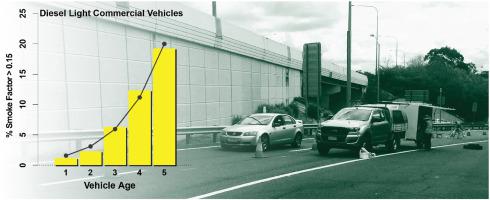Atmospheric Environment ( IF 5 ) Pub Date : 2021-03-04 , DOI: 10.1016/j.atmosenv.2021.118317 R. Smit , S. Bainbridge , D. Kennedy , P. Kingston

|
A remote sensing device (RSD) has been used at 23 locations across in Western Australia (20) and Queensland (3) in the period 2009–2019, generating more than 100,000 valid emission samples over more than a decade. After a statistical assessment of similarity and bias correction, the data were combined for this study to assess the performance of the light-duty vehicle (LDV) on-road fleet, i.e. cars, sport utility vehicles (SUVs) and light-commercial vehicles (LCVs). The percentage of excessive emitters is estimated to be about 2%. Diesel LDVs generally show stabilising or even increasing NOx-to-CO2 ratios with respect to progressive Euro classes. The RSD data confirm that the NOx emission issues with diesel vehicles in Europe are similarly observed in vehicles sampled in Western Australia and Queensland.
There is insufficient empirical evidence for a consistent reduction in real-world PM (‘soot’) emissions over progressive emission standards for diesel LDVs, after adjusting for the effect of vehicle age. Further analysis of Euro 5 diesel LDVs shows substantial differences between vehicle types. The diesel LCV and SUV mean smoke factors (Euro 5) are 141% and 64% higher than diesel passenger cars.
On average, across 1–5 years of vehicle age, 4% of the measured Euro 5 diesel cars have smoke factor values that suggest diesel particulate filters (DPFs) are malfunctioning, potentially modified or are not present. The percentages are higher for SUVs and LCVs, i.e. 7% and 12%, respectively. Pooled data for the two most recent years of manufacture (2017–2018) suggest that 1% of one-two year old diesel SUVs and 2% of one-two year old diesel LCVs have DPF issues, i.e. malfunctioning or potentially modified DPFs. These percentages are high when compared with a similar study conducted in the UK. The percentage of potentially malfunctioning or lack of DPFs in Euro 5 diesel LDVs shows a statistically significant trend (p < 0.05) and increases strongly with vehicle age in a non-linear fashion. This is in line with an increase in the number of smoky vehicles that were reported in the period 2015–2019, in particular for diesel vehicles.
中文翻译:

在澳大利亚使用遥感技术测量道路车辆排放的十年
2009-2019年期间,在西澳大利亚州(20)和昆士兰州(3)的23个地点使用了一种遥感设备(RSD),在过去的十多年中生成了100,000多个有效排放样品。经过对相似性和偏差校正的统计评估后,本研究的数据被合并以评估轻型车辆(LDV)公路车队的性能,即汽车,运动型多功能车(SUV)和轻型商用车( LCV)。过量排放物的百分比估计约为2%。相对于渐进的欧洲等级,柴油LDV通常显示出稳定甚至增加的NO x -CO 2比。RSD数据确认NO x 在西澳大利亚州和昆士兰州采样的车辆中,类似地观察到欧洲柴油车辆的排放问题。
在根据车辆使用年限进行调整之后,没有足够的经验证据表明,实际的PM(烟灰)排放量会持续降低,超过柴油LDV的渐进排放标准。对欧5柴油LDV的进一步分析表明,不同车型之间存在实质性差异。柴油LCV和SUV的平均烟雾系数(欧5)分别比柴油乘用车高141%和64%。
平均而言,在1-5年的车龄中,测得的Euro 5柴油车中有4%的烟熏系数值表明柴油机微粒过滤器(DPF)出现故障,可能被改装或不存在。SUV和LCV的百分比更高,分别为7%和12%。最近两个制造年份(2017-2018年)的汇总数据表明,一两年使用的柴油SUV的1%和一两年使用的柴油LCV的2%都存在DPF问题,即DPF故障或可能被改装。与在英国进行的类似研究相比,这些百分比很高。欧5柴油LDV中潜在故障或缺乏DPF的百分比显示出统计学上的显着趋势(p <0.05),并且随着车辆年龄的增长以非线性方式急剧增加。



























 京公网安备 11010802027423号
京公网安备 11010802027423号